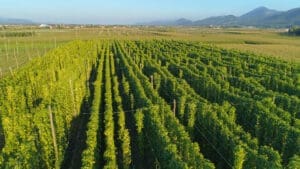As the wine region of California has expanded to other areas of the United States, it is common to see expansive rolling hills of vines producing their next vintage of grapes. But did you know that many of these regions are now also home to large fields of hops for beer production? Surprisingly, the cultivation of hops shares many similarities with grape vines, making them kindred spirits in the world of agriculture. Understanding these similarities and the ideal conditions for hop growth can provide a deeper appreciation for the intricate process behind your favorite brews.
 The Similarities Between Hops and Grape Vines
The Similarities Between Hops and Grape Vines
1. Ideal Climate for Growth
Both hops and grape vines thrive in temperate climates. They require distinct seasonal changes, with cold winters allowing for dormancy and warm summers allowing vigorous growth. Just as grape vines benefit from the heat and sunlight during their growing season, hops also need long sunny days to maximize their growth and resin production, which are crucial for beer flavor. Hops flourish in regions with a moderate climate, characterized by a combination of warm summers and cool winters. They require long daylight hours during the growing season, ideally 15 hours or more, which is crucial for the development of the hop cones. Temperatures between 60-70°F (15-21°C) during the growing season are ideal. Hops need ample water, especially during the first year of growth. However, they are sensitive to waterlogged conditions, which can lead to root rot and other diseases. Drip irrigation systems often provide consistent moisture without oversaturating the soil.
2. Soil Preferences
Both crops prefer well-drained soils. Hops, like grape vines, are susceptible to root diseases if waterlogged. Sandy loam soils with good fertility are ideal for hops, providing the necessary nutrients and drainage. Similarly, grape vines flourish in soils that are not overly rich but offer good drainage and mineral content. Well-drained sandy loam soils with a pH between 6.0 and 7.5 are perfect for hop cultivation. The soil should be rich in organic matter and nutrients, particularly nitrogen, to support the vigorous growth of hop bines. Regular soil testing and amendments are essential for optimal soil health and fertility.
3. Trellising Systems
The cultivation of both hops and grape vines involves the use of trellising systems. Hops grow as “bines,” climbing high on supports that can reach up to 20 feet or more, which helps them access sunlight and improves air circulation to reduce disease risk. Grape vines are trained along trellises to support the plant, optimize sunlight exposure, and improve air circulation, crucial for disease prevention and fruit quality. Hops require substantial vertical space to grow. A single hop bine can reach heights of 15-20 feet. Trellis systems, often constructed with tall poles and sturdy wires, are essential to support the climbing bines and allow for optimal sun exposure and air circulation.
4. Sensitivity to Pests and Diseases
Both hops and grape vines are vulnerable to various pests and diseases. Powdery mildew, downy mildew, and spider mites can affect both crops, necessitating vigilant monitoring and management practices. Integrated pest management and organic farming practices are commonly employed to protect these valuable crops without compromising quality.
Top Hop-Growing Regions in the United States
You’ll notice many similarities between the regions popular for growing wine grapes and hops. Here are some of the most popular areas for producing hops.
1. Pacific Northwest
The Pacific Northwest, particularly Washington, Oregon, and Idaho, is the leading hop-producing region in the United States. The Yakima Valley in Washington alone produces over 75% of the country’s hops. The region’s long daylight hours, fertile soils, and ideal climate make it perfect for hop cultivation.
2. California
California, known for its diverse agriculture, also has regions suitable for hop growing. The state’s mild climate and long growing season provide favorable conditions, particularly in areas like the Sacramento Valley.
3. Michigan
Michigan has emerged as a significant player in the hop industry thanks to its suitable climate and rich soils. The state’s northern latitude provides long daylight hours during the growing season, similar to the Pacific Northwest.
4. New York
Historically, New York was a major hop-growing region before Prohibition. Recently, the state has seen a resurgence in hop cultivation, particularly in the Finger Lakes and Hudson Valley regions, where the climate and soil conditions are favorable.
5. Colorado
Colorado’s high altitude and dry climate create a unique environment for hop growing. Regions like the Western Slope benefit from the intense sunlight and cool nights, which contribute to high-quality hop production.
Learn more about craft beer and beer production at The Growler Guys.
The journey from field to pint or glass of wine involves meticulous attention to the growing conditions and care of hops and grape vines. By understanding the similarities in their cultivation and the ideal conditions needed for their growth, we gain a greater appreciation for the agricultural artistry that underpins our favorite beverages. Stop by your local Growler Guys to try a variety of craft beers and learn more about the hops that go into their production. We can’t wait to see you soon!

 The Similarities Between Hops and Grape Vines
The Similarities Between Hops and Grape Vines
Reader Interactions